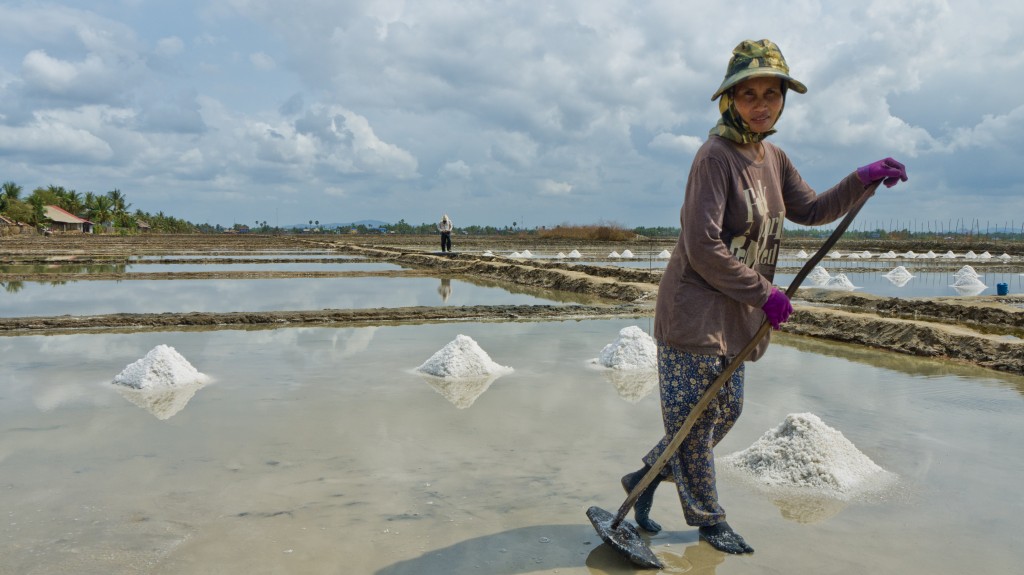
ស្ត្រីកំពុងធ្វើការនៅស្រែអំបិលក្នុងខេត្តកំពត។ រូបភាព ថតដោយ douglasjonesjr, ថ្ងៃទី២៨ មិនា ២០១៤។ ក្រោមអាជ្ញាប័ណ្ណ CC BY 2.0.
អំបិលត្រូវបានផលិតនៅក្នុងខេត្តកំពត និងខេត្តកែប ជាកន្លែងដែលទឹកសមុទ្រត្រូវបានបង្ហូរចូលក្នុងស្រែហាលធំៗ ហើយបង្ហូរបន្តទៅក្នុងវាលស្រែបណ្ដុះ។ នៅពេលដែលទឹកសមុទ្រហួតអស់ ក្រាមអំបិលស្ដើងៗបានដុះពាសពេញដីស្រែនោះ ហើយត្រូវបានកម្មករគៀងគរប្រមូលយកទៅទុកក្នុងឃ្លាំង។ ទិន្នផលផលិតកម្មពឹងផ្អែកយ៉ាងខ្លាំងទៅនឹងអាកាសធាតុ ប្រសិនបើរដូវប្រាំងមានរយៈពេលយូរ នោះទិន្នផលប្រចាំឆ្នាំនឹងកើនឡើង តែផ្ទុយទៅវិញ ទិន្នផលនឹងថយចុះបើសិនជាមានភ្លៀងធ្លាក់ច្រើន។ តម្រូវការប្រើប្រាស់អំបិលក្នុងស្រុក មានប្រហែលជាង ១០០.០០០ តោនក្នុងមួយឆ្នាំ។1 មុនឆ្នាំ ២០១៧ អំបិលកម្ពុជាមិនត្រូវបាននាំចេញទេ ដោយសារភាគច្រើនមានបញ្ហាគុណភាព មិនសមស្របទៅនឹងស្ដង់ដារអន្តរជាតិ។ យ៉ាងណាមិញ ក៏មានគម្រោងមួយបានដំណើរការដើម្បីកែលម្អគុណភាព និងចាប់ផ្តើមឧស្សាហកម្មនាំចេញអំបិល។2
ផលិតកម្មអំបិលបានឈានដល់ ១៤៧.០០០ តោនក្នុងឆ្នាំ ២០១៤ ស្មើនឹងជិតពីរដងនៃចំនួន ៨០.០០០ តោនដែលបានកត់ត្រាក្នុងឆ្នាំ ២០១៣។3 នេះគឺដោយសារតែរដូវប្រមូលផលឆ្នាំ ២០១៣ បានបញ្ចប់នៅខែមេសា ខណៈពេលដែលរដូវប្រាំងឆ្នាំ ២០១៤ បានបន្តរហូតទៅដល់ខែមិថុនា។ យ៉ាងណាមិញ ផលិតកម្មអំបិលបានធ្លាក់ចុះពី ១៧០.០០០ តោនក្នុងឆ្នាំ ២០១៥ មកត្រឹម ១៤០.០០០ តោនក្នុងឆ្នាំ ២០១៦ ហើយបន្តធ្លាក់ចុះត្រឹមតែ ៣២.០០០ តោនប៉ុណ្ណោះ នៅក្នុងឆ្នាំ ២០១៧។4
សហគមន៍អ្នកផលិតអំបិលខេត្តកំពត និងខេត្តកែប ត្រូវបានបង្កើតឡើងនៅឆ្នាំ ២០០៤ ហើយបច្ចុប្បន្នមានផ្ទៃដីចំនួន ៤.៥៦៩ ហិកតា5 ដែលចែកចេញជា ៧ មណ្ឌល៖ មណ្ឌលបឹងទូក មណ្ឌលត្រើយកោះ មណ្ឌលបឹងរូងទី១ មណ្ឌលបឹងរូងទី២ មណ្ឌលសេះស មណ្ឌលកែប និងមណ្ឌលកំពង់ត្រាច ដែលស្ថិតនៅតាមបណ្តោយឆ្នេរសមុទ្រ ផ្ដើមចេញពីឃុំបឹងទូក ស្រុកទឹកឈូ ទៅភូមិលក ឃុំឫស្សីស្រុកខាងលិច ស្រុកកំពង់ត្រាច ខេត្តកំពត ជាប់ព្រំដែនវៀតណាម។6
តម្លៃអំបិលកម្ពុជាប្រភេទល្អលេខ១ លក់បានតម្លៃជាមធ្យម ៣ ដុល្លារក្នុងបាវទម្ងន់៥០ គីឡូក្រាម ចំនែកឯអំបិលលេខ២ លក់បាន ២,៤ ដុល្លារ និងចុះមកត្រឹម ២,២ ដុល្លារសម្រាប់អំបិលថ្នាក់លេខ ៣។7
បណ្តាក់ទុនផលិតកម្មថ្មី
គម្រោងមួយដែលមានជំនួយគាំទ្របានបើកដំណើរការនៅស្រុកទឹកឈូ ខេត្តកំពត កាលពីខែមេសា ឆ្នាំ ២០១៣ មានគោលបំណងផលិតអំបិលសមុទ្រដែលមានគុណភាពអាចនាំចេញបានដំបូងគេបង្អស់របស់កម្ពុជា។8 ការបណ្តាក់ទុនចំនួន ២,៩ លានដុល្លារនេះ មានគោលដៅផលិតអំបិល ២០.០០០ តោនក្នុងមួយឆ្នាំសម្រាប់ការនាំចេញពីកសិដ្ឋានផលិតអំបិលទំហំ ១០០ ហិកតា។ គម្រោងមួយនេះ នឹងសាងសង់រោងចក្រវេចខ្ចប់។9
ក្រុមហ៊ុនអំបិលអាស៊ីកម្ពុជា (ខេមបូឌា) ជាក្រុមហ៊ុនបុត្រសម្ព័ន្ធក្នុងស្រុកមួយដែលមានទុនរួមគ្នារវាងក្រុមហ៊ុនកូរ៉េខាងត្បូង EEE Korea និងក្រុមហ៊ុន InfraCo Asia Development Pte. Ltd ដែលទទួលបានហិរញ្ញប្បទានដោយរដ្ឋាភិបាលអង់គ្លេស ស្វ៊ីស និងអូស្ត្រាលី។
តាមរយៈការណែនាំនូវការអនុវត្តល្អបំផុតក្នុងការចម្រាញ់យកអំបិលចេញពីទឹក ដោយប្រើប្រាស់ថាមពលព្រះអាទិត្យ គម្រោងនេះមានបំណងផលិតអំបិលឱ្យសមស្របសម្រាប់ការនាំចេញទៅទីផ្សារនៅកូរ៉េខាងត្បូង និងជាពិសេសប្រទេសជប៉ុន។
តម្លៃដើមទុននៃគម្រោងដំណាក់កាលដំបូងត្រូវបានគេប៉ាន់ប្រមាណថាមានចំនួន ២,៩ លានដុល្លារអាមេរិក។ ដំណាក់កាលទីពីរដែលត្រូវបានប៉ាន់ស្មានថាមានចំនួន ៧ លានដុល្លារអាមេរិក នឹងអាចបង្កើនសមត្ថភាពផលិតកម្ម បង្កើតរោងចក្រចម្រាញ់មួយ និងអាចនាំចេញអំបិលសមុទ្រធម្មជាតិដែលមានគុណភាពខ្ពស់ទៅទីផ្សារអន្ដរជាតិ។10
ប្រសិនបើការផលិតអំបិលកម្ពុជាទាំងអស់មានស្តង់ដារខ្ពស់ ស្របតាមការអនុវត្តល្អបំផុតរបស់អន្តរជាតិ នោះការព្យាករណ៍នៃឧស្សាហកម្មនាំចេញដែលមានតម្លៃរហូតដល់ទៅ ១០០ លានដុល្លារអាមេរិកជារៀងរាល់ឆ្នាំនឹងអាចលេចរូបរាងឡើង។11
ការនាំចេញអំបិលកម្ពុជា
រយៈពេលប៉ុន្មានឆ្នាំចុងក្រោយនេះ កម្ពុជាបាននាំចេញអំបិលរបស់ខ្លួនទៅកាន់ទីផ្សារអន្តរជាតិជាបន្តបន្ទាប់។ នៅដើមឆ្នាំ ២០១៧ ខែកុម្ភៈ ក្រោមកិច្ចព្រមព្រៀងជាមួយក្រុមហ៊ុនបារាំងឈ្មោះ Le Guerandais កម្ពុជាបាននាំចេញអំបិលចំនួន ២០ តោនទៅកាន់ទីផ្សារបារាំង ដែលជាការនាំចេញលើកដំបូងបង្អស់ និងលក់បានក្នុងតម្លៃ ៥៨ ដុល្លារក្នុងមួយតោន។12 យោងតាមមូលដ្ឋានទិន្នន័យរបស់ United Nations Comtrade Database អំបិលរបស់ប្រទេសកម្ពុជាបាននាំចេញទៅលក់ក្នុងទីផ្សាររបស់ប្រទេស ហូឡង់ ចំនួនប្រហែល ៩០០ តោន ដែលមានតម្លៃស្មើរនឹងទឹកប្រាក់ ៧៥០.០០០ ដុល្លារ នៅឆ្នាំ ២០១៦។13
បានធ្វើបច្ចុប្បន្នភាព៖ ០១ ខែកុម្ភៈ ឆ្នាំ២០១៨
ទាក់ទងនឹងអំបិល
ឯកសារយោង
- 1. ក្រសួងឧស្សាហកម្ម និងសិប្បកម្ម. (២០១៥). “វេទិកាសាធារណៈក្រុមការងារថ្នាក់ជាតិ ចុះមូលដ្ឋានខេត្តកំពត ជួបសំណេះសំណាល ស្វែងយល់ពីតម្រូវការ និងសំណូមពររបស់ក្រុមអ្នកផលិតអំបិលខេត្តកំពត-កែប”។ ចូលអានថ្ងៃទី ០១ ខែកុម្ភៈ ឆ្នាំ២០១៨។ http://www.mih.gov.kh/File/UploadedFiles/6_10_2015_11_25_57_025-2015%20Public%20Forum%20at%20Salt%20Community.pdf
- 2. ជា វណ្ណៈ. “ផលិតកម្មអំបិលនៅកម្ពុជា នៅតែពឹងផ្អែកលើអាកាសធាតុ”។ កាសែតខ្មែរថាមស៍, ចុះថ្ងៃទី ៣១ ខែកក្កដា ឆ្នាំ ២០១៧។ ចូលអានថ្ងៃទី ០១ ខែកុម្ភៈ ឆ្នាំ២០១៨។ http://www.khmertimeskh.com/5075584/salt-production-cambodia-still-seasonal
- 3. ហ៊ គឹមសាយ. “អ្នកផលិតអំបិលទទួលបានទិន្នផលខ្ពស់”។ កាសែតភ្នំពេញប៉ុស្ដិ៍, ចុះថ្ងៃទី ១២ ខែមិថុនា ឆ្នាំ២០១៤។ ចូលអានថ្ងៃទី ០១ ខែកុម្ភៈ ឆ្នាំ២០១៨។ http://www.phnompenhpost.com/business/salt-makers-shake-out-big-surplus
- 4. សុខ ចាន់. “ភ្លៀងធ្លាក់បង្អាក់ការប្រមូលផលរបស់កសិករផលិតអំបិលក្នុងស្រុក”។ កាសែតខ្មែរថាមស៍, ចុះថ្ងៃទី១២ ខែមករា ឆ្នាំ២០១៨។ ចូលអានថ្ងៃទី ០១ ខែកុម្ភៈ ឆ្នាំ២០១៨។ http://www.khmertimeskh.com/50101594/rain-keeping-local-salt-farmers-harvesting/
- 5. ក្រសួងឧស្សាហកម្ម និងសិប្បកម្ម. (២០១៥). “វេទិការសាធារណៈក្រុមការងារថ្នាក់ជាតិ ចុះមូលដ្ឋានខេត្តកំពត ជួបសំណេះសំណាល ស្វែងយល់ពីតម្រូវការ និងសំណូមពររបស់ក្រុមអ្នកផលិតអំបិលខេត្តកំពត-កែប”។ ចូលអានថ្ងៃទី ០១ ខែកុម្ភៈ ឆ្នាំ២០១៨។ http://www.mih.gov.kh/File/UploadedFiles/6_10_2015_11_25_57_025-2015%20Public%20Forum%20at%20Salt%20Community.pdf
- 6. ក្រសួងឧស្សាហកម្ម និងសិប្បកម្ម. (២០១៤). “ឯកឧត្តម ទេសរដ្ឋមន្ត្រី ចម ប្រសិទ្ធ អញ្ជើញចុះពិនិត្យ និងពង្រឹងការគ្រប់គ្របសហគមន៍អ្នកផលិតអំបិល ខេត្តកំពត និងខេត្តកែប”។ ចូលអានថ្ងៃទី ០១ ខែកុម្ភៈ ឆ្នាំ២០១៨។http://www.mih.gov.kh/File/UploadedFiles/7_22_2014_7_30_56_027-2014%20Salt%20Community%20Meeting.pdf
- 7. សុខ ចាន់. “ភ្លៀងធ្លាក់បង្អាក់ការប្រមូលផលរបស់កសិករផលិតអំបិលក្នុងស្រុក”. កាសែតខ្មែរថាមស៍, ចុះថ្ងៃទី ១២ ខែមករា ឆ្នាំ២០១៨។ ចូលអានថ្ងៃទី ០១ ខែកុម្ភៈ ឆ្នាំ២០១៨។ http://www.khmertimeskh.com/50101594/rain-keeping-local-salt-farmers-harvesting/
- 8. Simon Lewis. “កសិដ្ឋានអំបិលថ្មីនៅខេត្តកំពតមានមហិច្ឆតាធំក្នុងការផលិត”. កាសែតខេមបូឌា ដេលី, ចុះថ្ងៃទី ២៩ ខែមេសា ឆ្នាំ២០១៣។ ចូលអានថ្ងៃទី ០១ ខែកុម្ភៈ ឆ្នាំ២០១៨។ https://www.cambodiadaily.com/archives/new-kampot-salt-farm-has-big-ambitions-20505/
- 9. ដូចឯកសារយោងខាងដើម។
- 10. ក្រុមហ៊ុន Private Infrastructure Development Group. (២០១២). “របាយការណ៍ប្រចាំឆ្នាំរបស់ Private Infrastructure Development Group”។ ចូលអានថ្ងៃទី ០១ ខែកុម្ភៈ ឆ្នាំ២០១៨។ https://www.pidg.org/wp-content/uploads/2018/11/PIDG-Annual-Report-2012.pdf
- 11. ដូចឯកសារយោងខាងដើម។
- 12. ចេង សុខហ័ង. “កម្ពុជានាំចេញអំបិលជាលើកដំបូងទៅបារាំង”។ កាសែតភ្នំពេញប៉ុស្ដិ៍, ចុះថ្ងៃទី ១៤ កុម្ភៈ ឆ្នាំ២០១៧។ ចូលអានថ្ងៃទី ០១ ខែកុម្ភៈ ឆ្នាំ២០១៨។ http://www.phnompenhpost.com/business/first-salt-export-deal-crystallises
- 13. Robin Spiess, ចេង សុខហ័ង. “EU ស៊ើបអង្កេតការនាំចេញ អាស៊ីតស៊ីទ្រិច ពីកម្ពុជា”។ កាសែតភ្នំពេញប៉ុស្ដិ៍, ចុះថ្ងៃទី ២៦ ខែធ្នូ ឆ្នាំ២០១៧។ ចូលអានថ្ងៃទី ០១ ខែកុម្ភៈ ឆ្នាំ២០១៨។ http://www.phnompenhpost.com/business/cambodias-citric-acid-exports-prompt-investigation-europe

